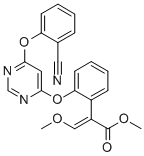아족시스트로빈 C화학적 특성, 용도, 생산
개요
Azoxystrobin is
a second broad-spectrum strobilurin fungicide (28,29).
It forms white solids with a mp = 116 ?C; vp = 1.1 ×
10?7 mPa at 25 ?C; logP = 2.5 at 20?C; water solubility =
6 mg/L; and a half-life of 11 to 17 days for aqueous
photolysis.
화학적 성질
White to beige crystalline solid or powder.
용도
Azoxystrobin has a very broad spectrum of activity and is active
against fungal pathogens from all four taxonomic groups, the Oomycetes,
Ascomycetes, Deuteromycetes and Basidiomycetes. It controls diseases
on cereals, rice, vines, apples, peaches, bananas, citrus, curcurbits,
potatoes, tomatoes, peanuts, coffee and turf.
정의
ChEBI: An aryloxypyrimidine having a 4,6-diphenoxypyrimidine skeleton in which one of the phenyl rings is cyano-substituted at C-2 and the other carries a 2-methoxy-1-(methoxycarbonyl)vinyl substituent, also at C-2. An inhibitor of mitochondrial respiration by b
ocking electron transfer between cytochromes b and c1, it is used widely as a fungicide in agriculture.
위험도
Moderately toxic by inhalation.
농업용
Fungicide: Azoxystrobin has been processed as a Reduced
Risk pesticide for Turf uses. Azoxystrobin is a systemic,
broad-spectrum fungicide that was first introduced in
1998. It inhibits spore germination and is used on grape
vines, cereals, potatoes, apples, bananas, citrus, tomatoes
and other crops. Largest crop uses in California are on
almonds, rice, pistachios, wine grapes, raisins and garlic.
Among the diseases it controls are rusts, downey and
powdery mildew, rice blast and apple scab. A U.S. EPA
restricted Use Pesticide (RUP)
상품명
ABOUND®; AMISTAR®; AMISTAR
OPTI; AMISTAR PRO; BANKIT®; HERITAGE®;
ICIA5504 80WG®; OLYMPUS®; ORTIVA®;
PROTEGE®; PROTEGE-ALLEGIANCE WP®;PROTEGE-FL SEED APPLIED FUNGICIDE®;
QUADRIS OPTI®; QUILT®; SOYGARD WITH
PROTEGE®
Safety Profile
Moderately toxic by inhalation.When heated to decomposition it emits toxic vapors ofNOx.
잠재적 노출
A β-methyoxyacrylate, Strobilurin is
an agricultural fungicide.
신진 대사 경로
Azoxystrobin is a recently developed fungicide with a novel mode of
action (see Overview for relevant references). It was first registered in
1996. It has been and is being subjected to the full range of studies to meet
current regulatory requirements for toxicology, metabolism and
environmental fate. Information on its metabolism and environmental
fate was presented as a lecture at the 9th International Congress of
Pesticide Chemistry (IUPAC) in 1998 and this will be published in the
Proceedings. The information presented below is derived from this source
(Joseph, 1998).
Azoxystrobin is a carboxylic acid methyl ester and one of its pathways
of metabolism is via hydrolysis to its carboxylic acid. The latter is not
biologically active (see Overview) and the favourable selective toxicity of
the fungicide is due to this and other metabolic reactions in non-target
species. Azoxystrobin is readily degraded in soil and ultimately mineralised
and it is metabolised in plants and animals. Metabolism is complex
because the molecule possesses several functional groups. Five different
pathways have been identified in plants and animals. Biotransformations
occurring on the parent molecule include hydrolysis, aromatic hydroxylation,
cleavage of both phenoxy linkages, nitrile to amide hydrolysis and
fragmentation of the acrylate double bond. Some photo-induced changes
also occur, including conversion to the (Z)-isomer.
신진 대사
Metabolites are also rapidly degraded in soil.
Photolysis studies show a DT
50 of 11 days. Due to the rapid
degradation and low soil mobility, no leaching is found in
field studies.
운송 방법
UN2811 Toxic solids, organic, n.o.s., Hazard
Class: 6.1; Labels: 6.1-Poisonous materials, Technical Name
Required. UN3082 Environmentally hazardous substances,
liquid, n.o.s., Hazard class: 9; Labels: 9-Miscellaneous
hazardous material, Technical Name Required.
비 호환성
Combustible; dust may form explosive
with air. Incompatible with oxidizers (chlorates, nitrates,
peroxides, permanganates, perchlorates, chlorine, bromine,
fluorine, etc.); contact may cause fires or explosions. Keep
away from alkaline materials, strong bases, strong acids,
oxoacids, epoxides.
폐기물 처리
Recycle any unused portion
of the material for its approved use or return it to the manufacturer
or supplier. Dispose of contents and container to
an approved waste disposal plant. Use a licensed professional
waste disposal service to dispose of this material.
Ultimate disposal of the chemical, product, and waste containers
must consider: the material’s impact on air quality;
potential migration in soil or water; effects on animal and
plant life; and conformance with public health, local, state,
and federal health and environmental regulations. Never
reuse or recycle used product containers unless the recycling
program specifically accepts pesticide containers and
you follow the program’s instructions for preparing the
empty containers for collection
아족시스트로빈 준비 용품 및 원자재
원자재
준비 용품








